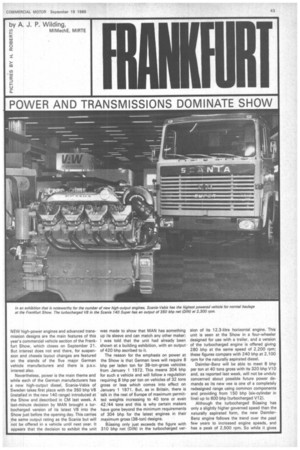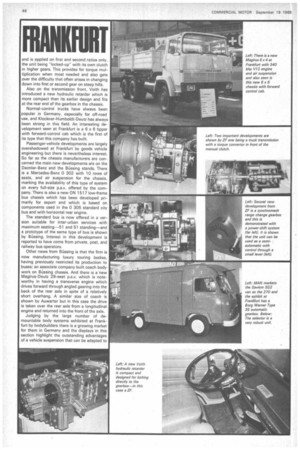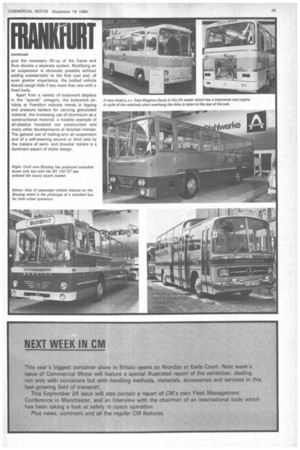f111111111111
Page 45

Page 46

Page 47

Page 48

Page 51

If you've noticed an error in this article please click here to report it so we can fix it.
POWER AND TRANSMISSIONS DOMINATE SHOW
NEW high-power engines and advanced transmission designs are the main features of this year's commercial vehicle section of the Frankfurt Show, which closes on September 21. But interest does not end there, for suspension and chassis layout changes are featured on the stands of the five major German vehicle manufacturers and there is p.s.v. interest also.
Nevertheless, power is the main theme and while each of the German manufacturers has a new high-output diesel, Scania-Vabis of Sweden takes first place with the 350 bhp V8 (installed in the new 140 range) introduced at the Show and described in CM last week. A last-minute decision by MAN brought a turbocharged version of its latest V8 into the Show just before the opening day. This carries the same output rating as the Scania but will not be offered in a vehicle until next year. It appears that the decision to exhibit the unit was made to show that MAN has something up its sleeve and can match any other maker: I was told that the unit had already been shown at a building exhibition, with an output of 420 bhp ascribed to it.
The reason for the emphasis on power at the Show is that German laws will require 8 bhp per laden ton for 38-ton-gross vehicles from January 1 1972. This means 304 bhp for such a vehicle and will follow a regulation requiring 8 bhp per ton on vehicles of 32 tons gross or less which comes into effect on January 1 1971. But, as in Britain, there is talk in the rest of Europe of maximum permitted weights increasing to 40 tons or even 42144 tons and this is why certain makers have gone beyond the minimum requirements of 304 bhp for the latest engines in their maximum gross (38-ton) designs.
Bussing only just exceeds the figure with 310 bhp net (DIN) in the turbocharged ver sion of its 12.3-litre horizontal engine. This unit is seen at the Show in a four-wheeler designed for use with a trailer, and a version of the turbocharged engine is offered giving 280 bhp at the same speed of 2,200 rpm; these figures compare with 240 bhp at 2,100 rpm for the naturally aspirated diesel.
Daimler-Benz will be able to meet 8 bhp per ton at 40 tons gross with its 320 bhp V10 and, as reported last week, will not be unduly concerned about possible future power demands as its new vee is one of a completely redesigned range using common components and providing from 150 bhp (six-cylinder in line) up to 600 bhp (turbocharged V12).
Although the turbocharged BUssing has only a slightly higher governed speed than the naturally aspirated form, the new DaimlerBenz engine follows the trend over the past few years to increased engine speeds, and has a. peak of 2,500 rpm. So while it gives more power, torque is down (742 lb.ft.) compared with the 853 lb.ft. of the BUssing.
The MAN V8 on which the current 304 bhp at 2,200 rpm unit is based was originally introduced two years ago with 250 bhp, this being increased last year to 280 bhp. Raising the output again is accompanied by a 2 mm increase in bore-126 to 128 mm—which makes the swept volume 15.4 litres as against 14.9. But it is doubtful that this alone could give the extra output. It is more likely that the revised bore diameter is in conjunction with changes such as fitting larger valves and improved breathing. When naturally aspirated, maximum torque is 758 lb.ft. at 1,600 rpm and increasing output to 350 bhp by turbocharging--maximum speed is the same—brings the torque up to 887 lb.ft. at 1,500 rpm.
Featuring the turbocharged V8 suggests that MAN believe in this form of power unit. And a second new engine development by the concern is a turbocharged version of its 10.7-litre six-cylinder diesel to get to the 256 bhp needed for the 1971 (32-ton-gross} German requirements.
To get to the higher powers KlocknerHumboldt-Deutz has new air-cooled vees which, although based on earlier designs, show detail changes. The two with the highest power are a V10 and V12. The V10 is a 14.1-litre diesel giving 290 bhp at 2,650 rpm and maximum torque of 641 lb.ft. at 1,300/1,600 rpm. Comparable figures for the V12, which has 17 litres, are 340 bhp and 770 lb.ft., this being the firm's entrant in the high-output stakes.
The Austrian company, Steyr-Daimler-Puch has been very active lately in the commercial vehicle field and introduced a new range of well-designed, attractively styled trucks at the Brussels Show earlier this year. Now the company has shown that it is also ready for the future German power-to-weight ratio by introducing a 12-litre V8 which gives 260 bhp net at 2,600 rpm and 586 lb.ft. torque when naturally aspirated but 320 bhp and 723 lb.ft. when turbocharged. This engine is designed for fitting in the type 1490 chassis which at present uses a 230 bhp turbocharged sixcylinder diesel: the V8 has the same bore and stroke dimensions and individual heads, so using many common parts.
Henschel trucks now carry the dual name "Hanomag-Henschel" and as the company is now an associate of Daimler-Benz that firm's V10 is used in the latest maximum-gross design on the Hanomag-Henschel stand. This is an F 163 LL four-wheeler designed for use with a trailer and has air suspension for the rear axle. There are in all four trucks with air suspension at the rear and leaf springs at the front on the Hanomag-Henschel stand, one of them being a rear-steered tractive unit with driven second axle—the F221 S-2 AL. Two years ago Henschel had a similar vehicle but with all-round steel suspension, when the firm also had exhibits with air suspension. In both these aspects Henschel seems to have started something.
There is a new Mercedes-Benz 6 x 4 with set-back steered and driven axle—the LPS 2232 and while this is the only one that follows the exact pattern set by Henschel in 1.967, both MAN and Bussing have twinsteer 6 x 2 tractors with set-back second axles. It is worth pointing out here that Scammell was the first company to introduce a tractive unit of this layout, back in 1965.
And the other four major German manufacturers have all taken up air suspension. Like Hanomag Henschel, Klockner HumboldtDeutz and Bussing use this system at the rear only, but Mercedes-Benz and MAN chassis have air springs all round. Bussing is actually making a big point at the Show of its ability to offer numerous variations on basic types and this applies particularly to suspension. I saw at least three different layouts for rear air springs and as an alternative to conventional semi-elliptic springs the firm employs threeleaf taper springs.
Air suspension not only gives an improved ride, it also allows for an easy method of adjusting the height of the chassis. With the current interest in demountable-body systems it is logical that this feature should be used by manufacturers as a selling point. DaimlerBenz and MAN can, by having all-round air suspension, offer more than a system with air at the rear only. The latter company is showing a 9.156 FL, 15-ton-gross four-wheeler with a demountable body and demonstrating how the unit can be placed on detachable legs without the need for additional jacks or similar devices.
Daimler-Benz has perhaps more new models and developments on its stand than any other exhibitor in the commercial vehicle section and makes the point that all forwardcontrol trucks are now fitted with synchromesh transmission. One of the gearboxes used is the new range-change unit developed by 2F.
There are, in fact, two important developments by this German gearbox manufacturer and while the range-change design works very well as a normal manual unit. ZF is demonstrating that a power-shift system can be applied to it, which, with the incor poration of an air-powered clutch system operated through the ratio-change lever, allows it to operate as a semi-automatic. The box has two-speed planetary gearing behind the main section which has five ratios, the lowest being a ''crawler". Because bottom in the high range gives overall gearing equal to one of the main ratios in "low" there are only nine usable ratios.
The demonstration gearbox showed that the system can work well, only a small lever being needed to change the gears: the ratio engaged was indicated on a dial. The second ZF development is the coupling of its WSK torque convertor to a conventional synchromesh gearbox. The torque convertor is mounted between the engine and the clutch and is applied on first and second ratios only, the unit being "locked-up" with its own clutch in higher gears. This provides for torque multiplication when most needed and also gets over the difficulty that often arises in changing down into first or second gear on steep hills.
Also on the transmission front, Voith has introduced a new hydraulic retarder which is more compact than its earlier design and fits at the rear end of the gearbox in the chassis.
Normal-control trucks have always been popular in Germany, especially for off-road use, and klockner-l-fumboldt-Deutz has always been strong in this field. An interesting development seen at Frankfurt is a 6 x 6 tipper with forward-control cab which is the first of its type that this company has built.
Passenger-vehicle developments are largely overshadowed at Frankfurt by goods vehicle engineering but there is nevertheless interest. So far as the chassis manufacturers are concerned the main new developments are on the Daimler-Benz and the BUssing stands, There is a Mercedes-Benz 0 302 with 10 rows of seats, and air suspension for the chassis, marking the availability of this type of system on every full-size p.s.v. offered by the company. There is also a new ON 1517 low-frame bus chassis which has been developed primarily for export and which is based on components used in the 0 305 standard city bus and with horizontal rear engine.
The standard bus is now offered in a version suitable for inter-urban services with maximum seating-51 and 51 standing—and a prototype of the same type of bus is shown by Bussing. Interest in this development is reported to have come from private, post, and railway bus operators.
Other news from Bussing is that the firm is now manufacturing luxury touring bodies, having previously restricted its production to buses; an associate company built coach bodywork on Bussing chassis. And there is a new Magirus-Deutz 29-seat p.s.v. which is noteworthy in having a transverse engine which drives forward through angled gearing into the back of the rear axle in spite of a relatively short overhang. A similar size of coach is shown by Auwarter but in this case the drive is taken over the rear axle from a longitudinal. engine and returned into the front of the axle.
Judging by the large number of demountable body systems exhibited at Frankfurt by bodybuilders there is a growing market for them in Germany and the displays in this section highlight the outstanding advantages of a vehicle suspension that can be adapted to give the necessary lift-up of the frame and thus obviate a separate system. Modifying an air suspension is obviously possible without adding substantially to the first cost and, of even greater importance, the bodied vehicle should weigh little if any more than one with a should weigh little if any more than one with a fixed body. 1166. Apart from a variety of bodywork displays
in the "special" category, the bodywork exA new small p. s. v. from Magirus-Deutz is this 29-seater which has a transverse rear engine.
hibits at Frankfurt indicate trends in tipping In spite of the relatively short overhang the drive is taken to the rear of the axle.
and pressure tankers for carrying granulated material, the increasing use of aluminium as a constructional material, a notable example of all-plastics insulated van construction and many other developments of detailed interest. The general use of trailing-arm air-suspension and of a self-steering second or third axle by the makers of semiand drawbar trailers is a dominant aspect of trailer design.












































































































































